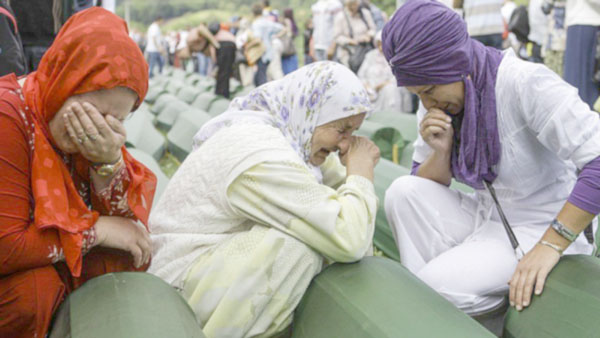“All who wish to go will be transported, large and small, young and old. Don’t be afraid… No one will harm you”
On 11 July 1995, Bosnian Serb units captured the town of Srebrenica in Bosnia-Herzegovina. In less than two weeks, their forces systematically murdered more than 8,000 Bosniaks (Bosnian Muslims) – the worst act of mass killing on European soil since the end of World War Two. Ratko Mladic, commander of the Bosnian Serb units, told the terrified civilians not to be afraid as his forces began the slaughter. They did not stop for 10 days.
Lightly-armed UN peacekeepers, in what had been declared a UN “safe area”, did nothing as the violence raged around them. Former Secretary-General Kofi Annan later declared: “The tragedy of Srebrenica will forever haunt the history of the United Nations.” The massacre – later judged as genocide – was committed against the Muslims by Bosnian Serb forces during the Bosnian War, one of several conflicts fought in the 1990s as Yugoslavia imploded.
The Socialist Republic of Bosnia and Herzegovina – as it was known when it was part of Yugoslavia – was a multi-ethnic region of Muslim Bosniaks, Orthodox Serbs and Catholic Croats. Bosnia-Herzegovina declared its independence in 1992 following a referendum, and was recognised shortly afterwards by the US and European governments.
But the Bosnian Serb population had boycotted the referendum. Soon afterwards Bosnian Serb forces – supported by the Serbian government – attacked the newly formed country. They began removing Bosniaks from territory in a bid to create a “Greater Serbia” – a policy known as ethnic cleansing. The Bosniak people, most of whom are Muslims, are descended from Bosnian Slavs who adopted Islam under Ottoman Turkish rule in the Middle Ages.
Bosnian Serb troops captured Srebrenica in 1992 but it was retaken by the Bosnian army soon after. A siege ensued with clashes between both sides. In April 1993, the UN Security Council declared the enclave a “safe area… free from any armed attack or any other hostile act”. But the siege continued. Supplies ran low for civilians and for a small force of Dutch soldiers operating as UN peacekeepers. Bosniak residents began to die of starvation.
On 6 July 1995, Bosnian Serb forces attacked Srebrenica in earnest. UN forces surrendered or retreated into the town, and NATO air strikes, called in to help, did little to slow the advance. The enclave fell within five days. Gen Mladic walked triumphantly through the town with other generals. Some 20,000 refugees fled to the main Dutch UN base. Killing began the next day. As Muslim refugees boarded buses for evacuation, Bosnian Serb forces separated out men and boys from the crowds and took them away to be shot.
Thousands were executed and then pushed into mass graves with bulldozers. Reports suggest some were buried alive, while some adults were forced to watch their children be killed. Women and girls meanwhile were taken out of the queues of evacuees and raped. Witnesses spoke of streets littered with corpses. Under-equipped Dutch soldiers witnessing the Serb aggression did nothing and about 5,000 Muslims sheltering at their base were handed over.
A UN tribunal in The Hague that investigated the events later spoke of the huge amount of planning that went into the massacre. “A concerted effort was made to capture all Muslim men of military age,” a judgement against one Bosnian Serb commander read.
Buses carrying women and children were systematically search for males, and often troops took young boys and elderly men who would not have been eligible to serve in the army. The effects of that massacre still reverberate to this day. New mass graves and bodies of victims are still being discovered, 25 years after the genocide.
A 2002 report blamed the Dutch government and military officials for failing to prevent the killings. The entire government resigned in the wake of the report. In 2019, the country’s Supreme Court upheld a ruling that the Netherlands was partially responsible for 350 deaths at Srebrenica.
In 2017, a UN tribunal in The Hague convicted Mladic of genocide and other atrocities. The commander had gone into hiding after the end of the war in 1995 and was not found until 2011, in his cousin’s home in northern Serbia.
Serbia has since apologised for the crime but still refuses to accept this was a genocide.


